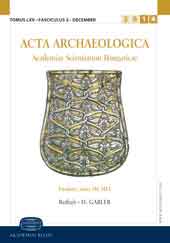A unique southeastern vessel type from early Calcholithic Transdanubia: data on the “western route”
A unique southeastern vessel type from early Calcholithic Transdanubia: data on the “western route”
Author(s): Eszter BánffySubject(s): Archaeology, Cultural history, Ancient World
Published by: Akadémiai Kiadó
Keywords: Vinča culture; Neolithic; Chalcolithic; Transdanubia;
Summary/Abstract: There are two staring points when dealing with connections between the Vinča culture and different phases of the Neolithic and Chalcolithic in Transdanubia (western Hungary). On the one hand, the western part of the Carpathian Basin is considered to be at least one of the key areas for mediating neolithic cultural impulses to Central Europe. On the other hand, there is evidence that the Vinča sphere of influence determined the whole neolithic development of a large area in the Mid-Balkans. Thus, it is no wonder that contacts between the two regions have been analysed in numerous studies. These contacts can be demonstrated repeatedly for various phases of the Neolithic, actually each time along very similar geographic routes, as we shall see later. While in some of these periods the network of communication is satisfactorily clear, some of them are still problematic. Here, I wish to focus attention on a less well understood period. This is the end of the Vinča culture which has connections with to the latest phase of the Lengyel culture. In absolute terms, it dates to about 4300 BC.
Journal: Acta Archaeologica Academiae Scientiarum Hungaricae
- Issue Year: 53/2002
- Issue No: 1-3
- Page Range: 41-60
- Page Count: 20
- Language: English
- Content File-PDF

